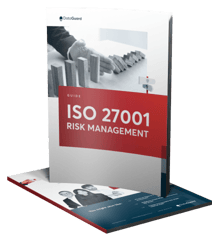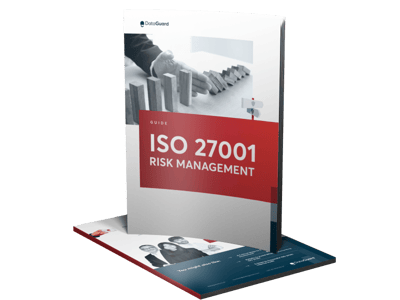It’s no longer enough for companies to just have a standard risk management process in place.
In fact, for companies to thrive and navigate today’s increasingly competitive and uncertain environment, it’s of the utmost importance to have a strong, dynamic, flexible risk management process that adapts and can deal with risks as they come.
This is especially true in the case of information security with the increased cybercrime and frequent regulatory changes.
What can you do as a business to implement proper risk management practices regarding information security?
Here’s where ISO 27001, the international standard for information security, can really help you understand, evaluate and deal with risks specific to your company. With its focus on risk management front and centre, adopting the standard can help you understand the risks you face and how you can deal with them.
This article covers what risk management is, why it is essential for your company, and how adopting the ISO 27001 standard can help you with implement it.
Let’s first look at what risk management is.
What is risk management?
Risk management is the continuous process of:
- Identifying, analysing, and evaluating risks your company may face (risk assessment).
- Ensuring strategies are in place to treat them (risk treatment).
Proper risk management can help you reduce uncertainty’s effect on achieving your business goals.
Why is risk management important for your business?
Some of the benefits of effective risk management are:
1. Improving operational resilienceYour business faces a various threats and risks from multiple sources every day. If you encounter an unexpected risk and are unprepared for it, in the worst case scenario, you may face significant losses. Risk management can help you prepare and set up processes to handle such unforeseen events.
2. Defending against cyber attacksCyber-attacks in the UK increased by 77% in 2022 compared to 2021. With companies continuing to digitalise, cybercriminals view them as attractive sources of sensitive information since they usually don’t have strong security procedures in place.
Risk management can help you identify vulnerabilities in your processes and fix them. It enables you to assess your most critical risks and prioritise their management accordingly.
3. Complying with data privacy regulations.Around the world, governments are strengthening their data privacy regulations, often modelled after the General Data Privacy Regulation (GDPR). Effective risk management is considered as one of the most important tools to achieve compliance with GDPR.
GDPR and other data privacy legislations impose heavy fines–up to 20 million Euros or 4% of global turnover–for non-compliance. This has made risk management a necessity in GDPR compliance.
How can ISO 27001 standard help you with risk management?
Since risk management is a continuous process, it requires a consistent and comparable set of guidelines to be implemented effectively. Having such a structure in place will ensure your risk assessment and treatment are transparent and objective.
However, building a risk management framework for your company from scratch can be challenging. Here’s where the ISO 27001 standard comes in.
What is ISO 27001?
- ISO 27001 is an international standard which helps companies like yours manage sensitive information from a risk management standpoint.
- It provides you with a set of guidelines, policies and controls to set up an effective information security management system (ISMS). These guidelines help you identify, analyse, and treat vulnerabilities in your systems and processes.
The ISO 27001 standard gives you a risk management framework which you can use to define the following criteria for risk management in your company:
- The company’s risk appetite
- The scale of risk
- Significant security criteria for your company
- Risk management methodology.
Risk management is a central pillar in complying with the ISO 27001 standard. It requires companies to show proof of information security risk management, list the controls they’ve used to manage risk, and justify why they have chosen to use the controls.
Implementing risk management according to ISO 27001 can also help you comply with GDPR.
What are the steps in an ISO 27001-compliant risk management process?
Risk management involves two key elements: risk assessment (to identify any risks your organisation may face) and risk treatment (to ensure that comprehensive risk mitigation strategies are in place to handle them).
Step 1: Risk Identification
The first step in creating an effective risk management system is identifying risks. This requires you to assess your:
- Information assets
- Internal and external threats
- Vulnerabilities in your information security management system (ISMS).
Once the risks associated with each asset or scenario are identified, you should assign them to a risk owner who will be responsible for handling the treatment of the particular risk.
Step 2: Risk Analysis
Once your risks have been identified, it’s time to analyse them based on their likelihood of occurrence and the impact they can have on the company.
Overall Risk = Likelihood x Consequences
Step 3: Risk Assessment
Risk assessment refers to the process of ranking risks from the greatest to the lowest using the outcome of risk analysis. Ranking risks can help you prioritise tackling the most critical ones.
Step 4: Risk Treatment
Risk treatment refers to the internal actions you take to transfer, avoid, mitigate, or accept the risk. Using ISO 27001 standard as a framework can help you with this. The standard lists several Annex A controls you can use to treat your risks.
The ISO 27001 standard requires you to record the Annex A controls you’ve used and omitted and your justification for choosing to do so. The document is known as the Statement of Applicability (SoA).
Now that you know the controls you’ll be implementing, you can start treating them by formulating a Risk Treatment Plan (RTP). It is a plan of action which shows the resources allocated for implementing the controls, the responsible parties and the deadlines.
The common ways of treating risks
The controls you could choose to treat risks can be broadly classified into four categories.
- Avoid - In this risk treatment method, risk is treated by completely avoiding or leaving the activities related to the risk. Discontinuing a product or service and choosing not to fund a risky project are some examples of avoiding risk.
- Reduce - If it is impossible to completely avoid the activity, you can take steps to mitigate the risk. Implementing controls to improve your data security is one way of mitigating the risk of data breaches.
- Transfer - A company can contractually transfer their risk to a third party to treat it. Insurance policies against natural disasters are a good example where the risk is shifted to the insurance company in exchange for a small premium.
- Accept - Even after all the other strategies are implemented, some risk is bound to remain unless you completely avoid the activity. This level of risk is known as residual risk, and your risk owners will have to accept it.
Step 5: Risk Monitoring
Risk management is a continuous process. Once you’ve implemented your controls, monitoring them regularly and ensuring they work properly is important. Some ways you can do this are:
- Involve employees in the risk management process.
- Conduct regular internal audits to identify new risks.
- Regularly review risks and their controls
Understanding the steps involved in managing risks can help you streamline the risk management process for your company. When implementing risk management, it is important to customise it to fit your specific needs.
Tips for effectively implementing risk management in your company
Your risk management approach should be tailored to your company. Using unsuitable tools and strategies because someone else does it can take up a significant amount of your resources and may not be very effective.
We’ve put together some tips for how you can tailor your risk management approach to best fit your company’s needs.
- Understand your industry-specific risks and compliance needs
The significant risks companies may face, and regulations they need to comply with differ from industry to industry. If you are a fintech company, your risks and compliance would differ from those operating in the retail services industry.
Some industries, like healthcare and financial services, are heavily regulated and this can pose risks on its own. Considering the requirements of the regulations can help you create a strong risk management process for your company.
- Select the suitable a suitable risk management methodology
Risk management methodologies are not one size fits all. They should be tailored for your specific needs, and the resources available to implement them. Your methodology should address the key requirements of ISO 27001 and avoid unnecessary steps.
Choosing an appropriate methodology will help you create a replicable and comparable risk management process every time you do it.
- Choose the right tools for implementation
Finding the right tools to effectively manage risks in your company is half the challenge. Consider the following factors when selecting a risk management tool.
- The specific risk management requirements of your company
- The level of complexity of your operations
- The most critical risk management features
- The cost includes acquisition, maintenance, and training costs.
- Ease of use and the need for extra training
- The right software for your company is best suited for your needs.
- Consider who should be involved in the process
Effective risk management is only possible when it involves and covers all aspects of your company. Form a cross-department team with input from all the departments since they know their processes best. Other than the heads of the department, some other key individuals who should be involved are:
- Senior management
- Risk specialists
- Legal and compliance experts
- External experts such as consultants and auditors
- Communicate the importance of risk management to employees and train them
It is important that employees understand the importance of risk management and the processes involved in it. As they’ll be implementing the processes, specialised training is critical. It helps you get the whole company on the same page and clarifies what risk management looks like in practice.
The many steps of risk management can seem challenging at first glance. However, with the right tools and some expert guidance, you’ll be able to take your first step in your company’s risk management process.
How can DataGuard help you with risk management?
With the risk management feature of our platform,
- Get control of your risks and reduce their negative impact - Our easy-to-use platform offers a visual overview of your greatest risks and vulnerabilities. It can help you prioritise which risks to tackle next.
- You can manage all the information around each risk (from description to cause & impact) using our platform and have an overview of everyone involved in the project.
- By evaluating the risks this way, you can get a consistent and comparable assessment of the threats your company face.
Are you interested in learning more about risk management? Get in touch with our experts today.
FAQs
1. What is information security risk management?Information security risk management (ISRM) is the process of identifying, assessing, and mitigating risks associated with a company’s information assets and systems.
The goal of ISRM is to ensure the company’s information assets are protected from threats and vulnerabilities such as theft, unauthorised access, data breaches, and cyber-attacks.
2. Does ISO 27001 have a risk-based approach?Yes, ISO 27001 takes a risk management approach to managing information security. The standard provides a framework to implement an Information Security Management System (ISMS) that is based on identifying, assessing, and managing information security risks.
3. How do you identify risk?Some ways you can identify risks are:
- Analyse your internal business processes and threats.
- Conduct stakeholder interviews.
- Review past data.
- Identify risks early.
- Align organisational goals to risk management plans.
- Manage risks within the context.
- Include stakeholders when coming up with your risk management plans.
- Clarify roles and responsibilities.
- Monitor and review continuously.
- Always strive for continuous improvement over perfection


ISO 27001 Risk Management
A free Guide on how to conduct Risk Management according to the industry standard ISO 27001.
Download Now - It's Free






